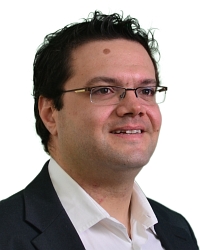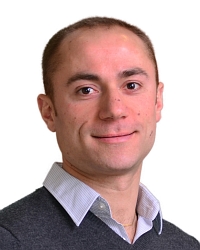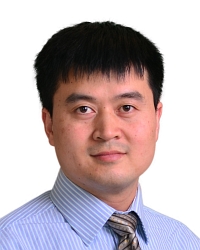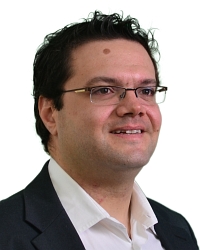TR2018-179
Sparse Blind Deconvolution for Distributed Radar Autofocus Imaging
-
- , "Sparse Blind Deconvolution for Distributed Radar Autofocus Imaging", IEEE Transactions on Computational Imaging, DOI: 10.1109/TCI.2018.2875375, Vol. 4, No. 4, pp. 537-551, December 2018.BibTeX TR2018-179 PDF Video
- @article{Mansour2018dec,
- author = {Mansour, Hassan and Liu, Dehong and Kamilov, Ulugbek and Boufounos, Petros T.},
- title = {Sparse Blind Deconvolution for Distributed Radar Autofocus Imaging},
- journal = {IEEE Transactions on Computational Imaging},
- year = 2018,
- volume = 4,
- number = 4,
- pages = {537--551},
- month = dec,
- doi = {10.1109/TCI.2018.2875375},
- url = {https://www.merl.com/publications/TR2018-179}
- }
- , "Sparse Blind Deconvolution for Distributed Radar Autofocus Imaging", IEEE Transactions on Computational Imaging, DOI: 10.1109/TCI.2018.2875375, Vol. 4, No. 4, pp. 537-551, December 2018.
-
MERL Contacts:
-
Research Area:
Abstract:
A common problem that arises in radar imaging systems, especially those mounted on mobile platforms, is antenna position ambiguity. Approaches to resolve this ambiguity and correct position errors are generally known as radar autofocus. Common techniques that attempt to resolve the antenna ambiguity general by assume an unknown gain and phase error afflicting the radar measurements. However, ensuring identifiability and tractability of the unknown error imposes strict restrictions on the allowable antenna perturbations. Furthermore, these techniques are often not applicable in near-field imaging, where mapping the position ambiguity to phase errors breaks down.
In this paper, we propose an alternate formulation where the position error of each antenna is mapped to a spatial shift operator in the image-domain. Thus, the radar autofocus problem becomes a multichannel blind deconvolution problem, in which the radar measurements correspond to observations of a static radar image that is convolved with the spatial shift kernel associated with each antenna. To solve the reformulated problem, we also develop a block coordinate descent framework that leverages the sparsity and piece-wise smoothness of the radar scene, as well as the one-sparse property of the two dimensional shift kernels. We evaluate the performance of our approach using both simulated and experimental radar measurements, and demonstrate its superior performance compared to state-of-the art methods.
Related News & Events
-
NEWS IEEE-NH ComSig lecture by MERL's Petros Boufounos Date: April 4, 2019
Where: Nashua Public Library, Nashua, NH
MERL Contact: Petros T. Boufounos
Research Areas: Computational Sensing, Signal ProcessingBrief MERL's Petros Boufounos gave a lecture for the IEEE-NH ComSig chapter at the Nashua Public Library as part of the IEEE Signal Processing Society Distinguished Lecturer series.
MERL's Petros Boufounos gave a lecture for the IEEE-NH ComSig chapter at the Nashua Public Library as part of the IEEE Signal Processing Society Distinguished Lecturer series.
Title: "An Inverse Problem Framework for Array Processing Systems."
Abstract: Array-based sensing systems, such as ultrasonic, radar and optical (LIDAR) are becoming increasingly important in a variety of applications, including robotics, autonomous driving, medical imaging, and virtual reality, among others. This has led to continuous improvements in sensing hardware, but also to increasing demand for theory and methods to inform the system design and improve the processing. In this talk we will discuss how recent advances in formulating and solving inverse problems, such as compressed sensing, blind deconvolution, and sparse signal modeling can be applied to significantly reduce the cost and improve the capabilities of array-based and multichannel sensing systems. We show that these systems share a common mathematical framework, which allows us to describe both the acquisition hardware and the scene being acquired. Under this framework we can exploit prior knowledge on the scene, the system, and a variety of errors that might occur, allowing for significant improvements in the reconstruction accuracy. Furthermore, we can consider the design of the system itself in the context of the inverse problem, leading to designs that are more efficient, more accurate, or less expensive, depending on the application. In the talk we will explore applications of this model to LIDAR and depth sensing, radar and distributed radar, and ultrasonic sensing. In the context of these applications, we will describe how different models can lead to improved specifications in ultrasonic systems, robustness to position and timing errors in distributed array systems, and cost reduction and new capabilities in LIDAR systems.
Related Video
Related Publications
- @inproceedings{Mansour2018apr,
- author = {Mansour, Hassan and Kamilov, Ulugbek S. and Liu, Dehong and Boufounos, Petros T.},
- title = {Radar Autofocus Using Sparse Blind Deconvolution},
- booktitle = {IEEE International Conference on Acoustics, Speech, and Signal Processing (ICASSP)},
- year = 2018,
- pages = {1623--1627},
- month = apr,
- doi = {10.1109/ICASSP.2018.8462402},
- url = {https://www.merl.com/publications/TR2018-003}
- }


